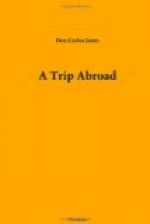Bunhill Fields is an old cemetery where one hundred and twenty thousand burials have taken place. Here lie the ashes of Isaac Watts, the hymn writer; of Daniel De Foe, author of “Robinson Crusoe,” and of John Bunyan, who in Bedford jail wrote “Pilgrim’s Progress.” The monuments are all plain. The one at the grave of De Foe was purchased with the contributions of seventeen hundred people, who responded to a call made by some paper. On the top of Bunyan’s tomb rests the figure of a man, perhaps a representation of him whose body was laid in the grave below. On one of the monuments in this cemetery are the following words concerning the deceased: “In sixty-seven months she was tapped sixty-six times. Had taken away two hundred and forty gallons of water without ever repining at her case or ever fearing the operation.”
Just across the street from Bunhill Fields stands the house once occupied by John Wesley (now containing a museum) and a meeting-house which was built in Wesley’s day. The old pulpit from which Mr. Wesley preached is still in use, but it has been lowered somewhat. In front of the chapel is a statue of Wesley, and at the rear is his grave, and close by is the last resting place of the remains of Adam Clarke, the commentator.
A trip to Greenwich was quite interesting. I visited the museum and saw much of interest, including the painted hall, the coat worn by Nelson at the Battle of the Nile, and the clothing he wore when he was mortally wounded at Trafalgar. I went up the hill to the Observatory, and walked through an open door to the grounds where a gentleman informed me that visitors are not admitted without a pass; but he kindly gave me some information and told me that I was standing on the prime meridian. On the outside of the enclosure are scales of linear measure up to one yard, and a large clock.
After the trip to Greenwich, I went over the London Bridge, passed the fire monument, and came back across the Thames by the Tower Bridge, a peculiar structure, having two levels in one span, so passengers can go up the stairs in one of the towers, cross the upper level, and go down the other stairs when the lower level is opened for boats to pass up and down the river. While in Scotland, I twice crossed the great Forth Bridge, which is more than a mile and a half long and was erected at a cost of above fifteen millions of dollars. There are ten spans in the south approach, eight in the north approach, and two central spans each seventeen hundred feet long. The loftiest part of the structure is three hundred and sixty-one feet above high-water mark.
The Albert Memorial is perhaps the finest monument seen on the whole trip. The Victoria and Albert Museum contains the original Singer sewing-machine, and a printing-press supposed to have been used by Benjamin Franklin, and many other interesting things. The Natural History Museum also contains much to attract the visitor’s attention. Here I saw the skeleton of a mastodon about ten feet tall and twenty feet long; also the tusks of an extinct species of Indian elephant, which were nine feet and nine inches long. There is also an elephant tusk on exhibition ten feet long and weighing two hundred and eighty pounds.




